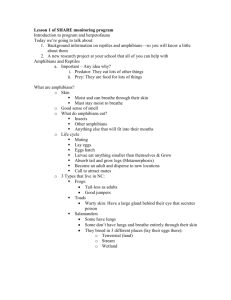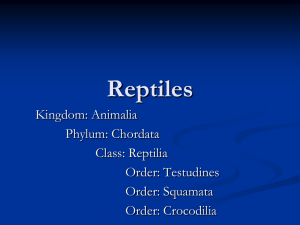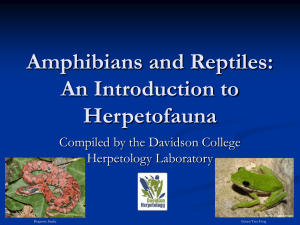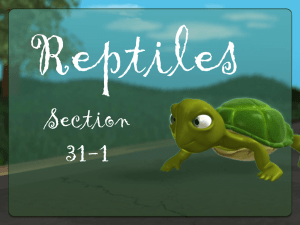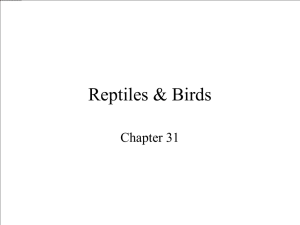Costa Rica Reptiles
advertisement
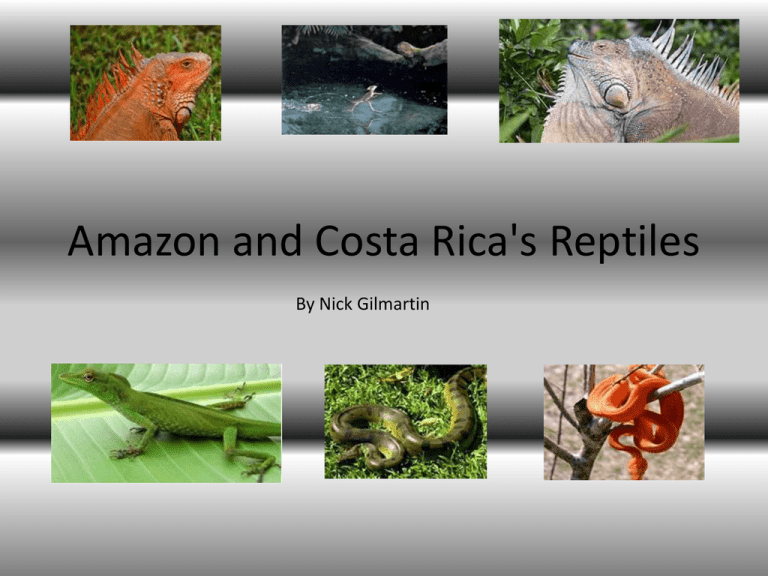
Amazon and Costa Rica's Reptiles By Nick Gilmartin There are about 200 species of reptile in the Amazon rainforest. There is nearly every family of reptile there, including crocodilian, snake, lizard, amphisbaenas, turtle, and tortoise. Here are some of the amazons most shocking reptiles in my opinion. Black Caiman • Once hunted to near extinction, the black caiman has made a rapid recovery and is now In the lower risk zone. A caiman is a type of crocodilian, but isn't a crocodile, nor an alligator, it is its own species. Most adults reach 14 feet and around 230 pounds; although some have been recorded about 16 feet and 880 pounds! This is the only species of crocodilian in the Amazon. Giant Amazon River Turtle • Many people think that turtles and tortoises are amphibians because they spend so much time in the water, this is not true. Turtles and tortoise are both reptiles. The giant Amazon river turtle can weigh up to 200 pounds and is one of the biggest freshwater turtle species. They also lay 50 to 200 eggs, and the laying is one of the few times this turtle ever leaves the water. Anaconda • Many people hear the word anaconda and think the worlds longest snake, this is not true. It is the heaviest snake in the world, weighing up to 235 pounds, and the second longest at 28 feet record. There have been many reports of anacondas over 30 foot but none have actually been verified. There are 2 types of anaconda, the Green Anaconda and the Yellow Anaconda. The Green Anaconda can be seen in the Amazon. Amazon Tree Boa • These snakes grow to 5 - 6.5 feet. They have been known to be very aggressive, but they are not venomous and pose little threat. It spends a lot of its time up in trees, and its color can change greatly between different snakes. This is a very beautifully colored snake, many also have intricate patterns. This snakes main prey is small birds in the trees. Costa Rica's reptiles vary greatly also, there are snakes, lizards, crocodilians and turtles. Costa Rica has a lot of coastline reptiles too, yet many of the reptiles such as the Fer de lance live in both the Amazon and Costa Rica's rainforests. Here are some of the most shocking reptiles from Costa Rica in my opinion. Basilisk • Also known as the “Jesus Christ lizard” because of its capability to run on top of water. Younger basilisks can run 10 to 20 meters on water! They are about 250 millimeters at full grown and weigh 600 grams. There clutches can be from 2 to 18 eggs. Basilisk in Greek means “little king”. They have very tall crests on there back giving them a very otherworldly appearance. People in Costa Rica often see these running across public pools. Green Iguana • This giant lizard has been known to grow up to 6.6 feet (head to tail) but are normally fully grown at around 4.9 feet. These prehistoric looking lizards are actually herbivores. And because of there tameness and striking colors they are often made pets. These lizards have a large dewlap (many lizards have dewlaps). A dewlap is a flap of skin underneath the chin that can expand and retract. Leatherback Turtle • This is the largest turtle living. It is a sea turtle and spends little of its life on land. Sea turtles limbs are actually flippers because most of their life is at sea. When a female sea turtle comes ashore to lay her eggs, she digs a pit on the beach and lays 25-100 eggs in it, then covers the pit. When the turtles hatch they will dig themselves out and make a break towards the water. Many predators such as seagulls eat the babies before they reach the water, so many people keep the seagulls away and shine flashlights in the water to attract the turtles in the right direction. Otherwise the turtles might be attracted to the lights of a city and go in the wrong direction. At fully grown they are 4 to 8 feet long and 600 to 800 pounds. A main part of these turtles diet are jellyfish, and their population is dwindling because many mistake floating plastic bags for their food. Fer De Lance • An extremely venomous snake; It is in the pit viper family, so it is related to the bushmaster and rattlesnakes. It has heat sensors in pits on its heads that help it detect its warm blooded prey, therefore the name “pit viper”. This snake can reach up to 9 feet long but is normally at 5-6 feet. This snake can also spit venom accurately up to 2 meters, to blind its attacker, or prey. • Now that I have showed you some of the stunning reptiles of these rainforests, and hopefully drawn you in, I will show you how certain reptiles species survive, and how they have adapted to survive in their habitats; what special features they have, ect. Pit vipers • Pit vipers, such as the Fer De Lance have special pits in their head. These pits are located in-between the eyes of a viper. These pits help them “see heat”. Almost like infrared. Bats can also do this. This is used to hunt their prey, which is normally small rodents and bats. This is considered a sixth sense. How they see there prey Crocodilians aestivation • Aestivation is very similar to hibernation. But instead of in the cold season, it is in the hottest, driest season. Crocodilians ( any species of crocodile or alligator) dig a large burrow on the banks of a river. It is just small enough for a crocodile to fit in, but after a tunnel there is a large rooms where many aestivate together. Most of the time crocodilians aestivate when the water has dried up in their river or pond. Aestivation Den Entrances. Water walking • The basilisk or Jesus Christ lizard is notorious for its water walking. This is made possible because of many things, one is there weight, they weigh about ¼ of a pound when young. Another is that when they put there foot down a fringe opens up increasing the surface area of the foot. As they step down it creates a sort of hole in the water that pushes up on the lizards foot. This creates 110% to 225% of the force needed to run on water. But if the lizard does not pull its foot out of the hole, it will fall or sink. If humans were able to do this they would have to run 65 miles per hour and exert 15 times the amount of energy that humans can expend. Unhinged Jaw • Snakes jaws are connected by ligaments. These ligaments can stretch. This is for a snake that is going to consume a meal bigger than itself, all snakes swallow their meals whole. They stretch their mouth open and fit the prey inside. Once inside, there are special bones that almost act as teeth, chewing the prey and moving it down into the stomach. The stomach can also stretch. For Example, if an anaconda in the Amazon attacks a caiman, it will constrict it to death then “unhinge” or stretch out its jaw to get its body through its head. Snakes also have a special breathing tube for when they have a mouth full of prey. Breathing tube, or Glottis Thanks for watching my Slideshow!
